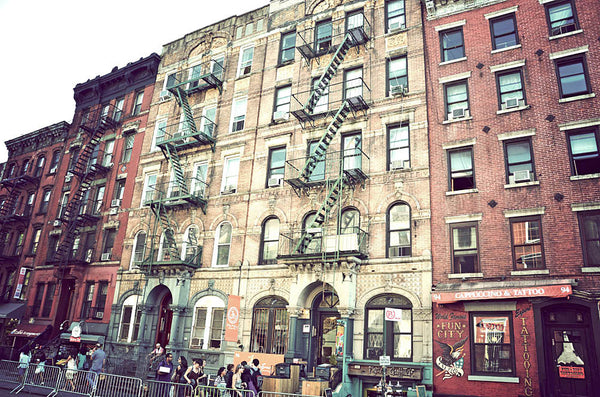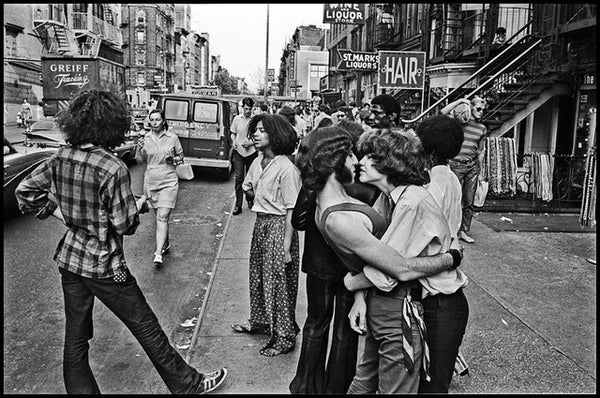St. Marks Is Dead and the Gentrification February 07 2016

Mariagrazia de Luca
Ada Calhoun, in her book St. Marks Is Dead tells the readers about St. Marks Place, a street of just 3 blocks (from 3rd Ave to Ave A, from Avenue B to Avenue D), in the heart of the East Village, where many things happened over the years and centuries.
Ada Calhoun is a young writer from New York who has just published a book, St. Marks Is Dead, which had a great success among critics and readers (newyorkers and not). Ada, despite her young age, has many years of experience as writer.
Besides working for The New York Times, The Republic, The New York Magazine, she has been a “crime reporter” for the New York Post. Her experience as “detective” helped her dealing with the huge amount of research, which is behind her extraordinary book. The first chapter of her book talks about St. Marks even before it was named St. Marks, and Manhattan was a forest inhabited by Native Americans. Ada Calhoun then tells the readers about the first colonists, the migration waves of Germans into the neighborhood (St. Marks was at that time the Little Germany!), about the anarchists who lived there (and the street’s nickname was Hail Marx Place), about the Mafia’s wars, when gangsters dug “underground tunnels” (and the Italian Mafia was of the most threatening). Then she talks about the hippies, the punk rockers, the skinheads. Can you imagine Patti Smith and the Ramones hanging out at St. Marks? Finally, Ada describes St. Marks today: a Living Museum, with Japanese restaurants, Chase bank, Starbucks, super expensive rents and the legendary clubs which are now closed. In St. Marks there are still vintage stores, like the famous “Search & Destroy”, but the energy of that glorious époque is becoming weaker and weaker. Despite that, Ada Calhoun concludes by saying that St. Marks Place is still the beating heart of the Big Apple.

Mariagrazia: Ada, you were born and grew up in St. Marks Place. Despite that, in your book, you don’t talk about your personal memories, instead you give space to the “History” and about the myriad of “stories” which happened on this special street in New York. How did you get to know about all of it, and what does it mean to grow up in a place as St. Marks?
Ada: It’s funny, because when I was growing, and since I started researching I didn’t know any of the stories of St. Marks. I wish I’ve known earlier, when I was younger, because when you know the history and you walk down the street, I would look at each building and see the past layers of it. I would have thought, ‘these or those famous people used to live there!’ I would have felt myself in the continuous of the history of St. Marks, part of the past and the future at same time.
Mariagrazia: Did it feel “normal” to you to grow up in St. Marks?
Ada: Yes. St. Marks was a place like many others. It felt normal to me to live there. The first time I went to the suburb was when I was 11 years old, to visit a cousin of mine in Ohio, in a very small town. Once I got there, I didn’t know how everything worked. I didn’t know the rules for the football, I didn’t know what a drive-in was. I thought that everything was amazing and it was so fun, and the city looked to me instead awful. I wished to live in the countryside. Now, of course, I appreciate where I grew up, and all the stories of St. Marks Place.

Mariagrazia: I read in your book that you wished to become a farmer?
Ada: Yes, but soon after I found that the countryside was boring. It ruins a little to grow up in the city.
Mariagrazia: In Italy we all grow up “eating” a lot of American culture. I think about the “people” who usually hung out in St. Marks, like Andy Warhol, the Ramones… these people influenced enormously the Italian rock music and the Italian artistic scenario in general. I am wondering if it does exist a “Roman” street very similar to St. Marks Place? Perhaps there are some Italian “copies” of St. Marks Place in which you can have a similar cultural environment than here in the East Village (I am thinking about San Lorenzo, the university neighborhood)...
Ada: That’s funny. I’ve been in Rome for my honeymoon… I honestly don’t know. Someone told me that a street similar to St. Marks in Paris is Saint- Germain-des-Prés.
Mariagrazia: In your book you mention St. Marks’ “golden age”. You said that there wasn’t just one golden age for St. Marks Place, instead there were many. Is it true?
Ada: Right. My golden age was when I was a teenager, during the ‘90. When I was doing the interview for the book, I noticed that everybody was saying that there was a specific year that was a wonderful year. Someone said it was the 1954, someone the 1997 and so on. I started doing math, and thinking how old people were in these years, and I found out mostly they were exactly in their nineteen, their “golden age”
Mariagrazia: being 19 today in St. Marks Place or being 19 during the ‘70 or ‘80, when all the rockers used to play around in the legendary East Village’s clubs? How is it different? Is still “authentic” St. Marks today?
Ada: I don’t really know what’s happening today in St. Marks. We don’t know until later. Nobody knew about the Ramones when they started. They were just 4 kids from Queens, they played loud and were considered annoying, and only later people realized they were some of the best musicians ever. There are things happening in the city now that only kids know about it and we don’t know.
Mariagrazia: Is there a neighborhood in New York, which is more a “hot spot” than other, since St. Marks became kind of touristic? I thought about Bushwich, where there are so many artists, rock concerts, disco, etc.

Ada: Yes. In Bushwick people is very free, young people can effort to live better, cheaper. There are new galleries, indie concerts….
Mariagrazia: I was thinking about St. Marks place as an “extreme mirror”, where things happen earlier than everywhere and are often so extreme and relevant for New York and the whole world….
Ada: I like the metaphor of the “extreme mirror”. St. Marks is “more New York” than other part of the city. During the big immigration, there were more immigrants here, during the ‘70, when New York was decrepit and broken down, St. Marks was more decrepit and broken down than the rest of the city. Today is, instead, richer than other areas. Here there have been riots, union organizers, a lot of energy. Still today there is so much energy and you can see teenagers hanging out in the street at 2 a.m…
Mariagrazia: in one of my explorations of New York, looking for this specific ‘70 and ‘80 rock atmosphere, I ended up in the legendary rock club CBGB, which today is just a very expensive clothes store. Anyway, you can see inside some “evidence” of the old CBGB’s wall, with the old concert’s flyers on…
Ada: Right. I used to go to the CBGB when I was teenager. You had a lot of bands playing there, some were ok, some really bad. Rockers, rappers, hardcore musicians, etc. There were less people going there in the ‘90s: there wasn’t anymore the same energy.
Mariagrazia: there are so many characters in your book: Mr. Zero, Skateborders, Mafia guys, philanthropists… how did you collect all these stories?
Ada: I just did so many interviews, more than 250. I talked to people on the street, each person directed me to five more people: I had a list of 700 people at a certain point. I asked them to tell me their favorite story or memory of the street, just things that happened on the street. When they started talking about uptown I told them, no, no, I don’t care. For the research, I spent a lot of time in the library, and I tried to research through all different keywords. I looked for every single book about St. Marks, hundreds of books. I look into archives, I went to museums. People let me look into their basement or gave me old magazines. I also bought old pictures from the ‘60 and ‘70 in e-bay for a few bucks.
Mariagrazia: Has your job as a “crime reporter” for the New York Post helped in writing your book?
Ada: Yes. I tracked people, found them and interviewed them for my book.
Mariagrazia: How long did it take you to complete your book?
Ada: four, five years.
Mariagrazia: Are you planning to translate it into Italian? In your book there are so many stories which might interest Italian readers.
Ada: I would love to.
Mariagrazia: Was the Italian Mafia really so powerful in St. Marks Place?
Ada: yes, it was. During the ‘20 the Jewish Mafia and the Italian Mafia were so powerful and they hated each other… There was a dramatic shooting on St. Marks Place between the two gangs. The Italian Mafia, the Black Hands, were so cruel and threatening. Italian Mafia guys used to give black lollipops to the kid in the school of the East Village, to menace the parents: you see? We can get to your kids!
Mariagrazia: How you invision St. Marks in 10 years?
Ada: I think St. Marks will be always a special destination. There are so many Europeans here in the East Village today, you can listen to so many accents walking down the street. I don’t know what people would be wearing, probably something that would look ridiculous to us. There is also a nice promenade from the subway to the park. I also believe, eventually, it would stop to be so expensive.
Mariagrazia: And maybe you will be able to come back in St. Marks?
Ada: why not?




